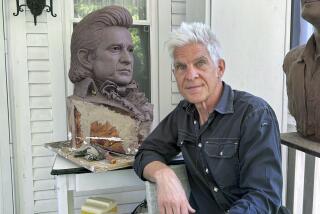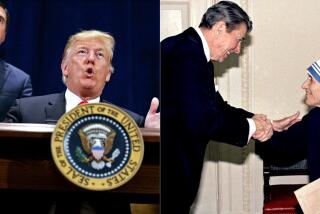A Bit Too Early for Sainthood
Until this week, the status of Alexander Hamilton appeared not only secure but on the ascent as one of the central figures of the American Revolution. However, on the very eve of the 200th anniversary of his death, Hamilton is now facing the equivalent of decanonization -- a congressional act to remove him from the face of the $10 bill and replace his image with that of Ronald Reagan. In fact, as Republicans vie to satisfy what is becoming a cult-like obsession with Reagan memorials, Franklin Delano Roosevelt may be replaced by Reagan on the dime. The urgent move among Republicans in Congress to replace Hamilton and Roosevelt may involve some genuine respect, but it certainly also reflects some opportunism by disciples eager to strike while Reagan critics are forced to observe a respectful silence.
If the decanonization of Hamilton and Roosevelt is premature, so is the canonization of Reagan only days after his death. What is lacking is the objectivity needed to weigh the relative contributions of leaders like Hamilton, Roosevelt and Reagan.
For the record:
12:00 a.m. June 11, 2004 For The Record
Los Angeles Times Friday June 11, 2004 Home Edition California Part B Page 13 Editorial Pages Desk 0 inches; 27 words Type of Material: Correction
Currency -- A Wednesday commentary on memorials to Ronald Reagan incorrectly stated that President Andrew Jackson is on the $50 bill. He appears on the $20 bill.
For six centuries, the Vatican employed a priest called the devilâs advocate to challenge any sainthood candidate, arguing his or her flaws and failings to test the claim of saintliness. In Reaganâs case, few in Congress are eager to question the relative credentials of an American icon in the aftermath of his death.
At one time, Reagan supporters were content with their stated desire to have their man on the dime rather than Roosevelt, credited with such small feats as saving the nation from the Great Depression and the world from fascism. Roosevelt is long dead, however, and what has he done for us lately?
Hamilton appears doomed by two factors: the declining value of the dime and the fact that he graces one of the most used bills -- making his decanonization far more attractive for Reagan supporters. Finally, Hamilton lacks any lobby or constituency beyond a few endomorphic academic geeks.
Reagan, by contrast, has an actual committee -- the Ronald Reagan Legacy Project -- which spends all its time trying to get things named after Reagan.
In Washington, it seems, one may soon be able to move from Reagan memorial to Reagan memorial without touching non-Reagified ground. There is a move to give Reagan a memorial on the Mall, like Abraham Lincoln. Congress built a $338-million, 3.1-million-square-foot government complex for Reagan. Then someone noticed that the capitalâs airport was named after some president named George Washington, so it was promptly renamed after Reagan. There is a mountain in New Hampshire named after Reagan, as well as an aircraft carrier in the Pacific and thousands of other âlegacyâ memorials. Congress members are also pushing to squeeze Reagan onto Mt. Rushmore.
At the least, Congress could give us the choice of which prior leader to discard in favor of Reagan. There are far better candidates for decanonization. There is William McKinley on the $500 bill and Grover Cleveland on the $1,000 bill. Former Secretary of the Treasury and Supreme Court Justice Salmon Chase was given the $10,000; he -- not such greats as Chief Justice John Marshall or justices Louis Brandeis or Oliver Wendell Holmes -- is the only jurist on a bill.
Better yet, we could remove Andrew Jackson from the $50 bill. Jackson is hardly a figure worthy of such an honor. Whereas some of the others did little good, Jackson did much harm. After the Battle of New Orleans, Jackson exercised dictatorial powers and engaged in outrageous attacks on his critics. He later defied the Supreme Court and, in open violation of the Constitution, ordered the eviction of the Cherokees from their land -- an act that led to the infamous âTrail of Tearsâ and probably would be defined today as a crime against humanity.
The effort to replace Hamilton and Roosevelt proves the need to have a moratorium on any government memorial to a president for 25 years after his death. There is already such a moratorium for Mall memorials, which some members are seeking to override. It was a law signed in 1986 -- by Ronald Reagan.


